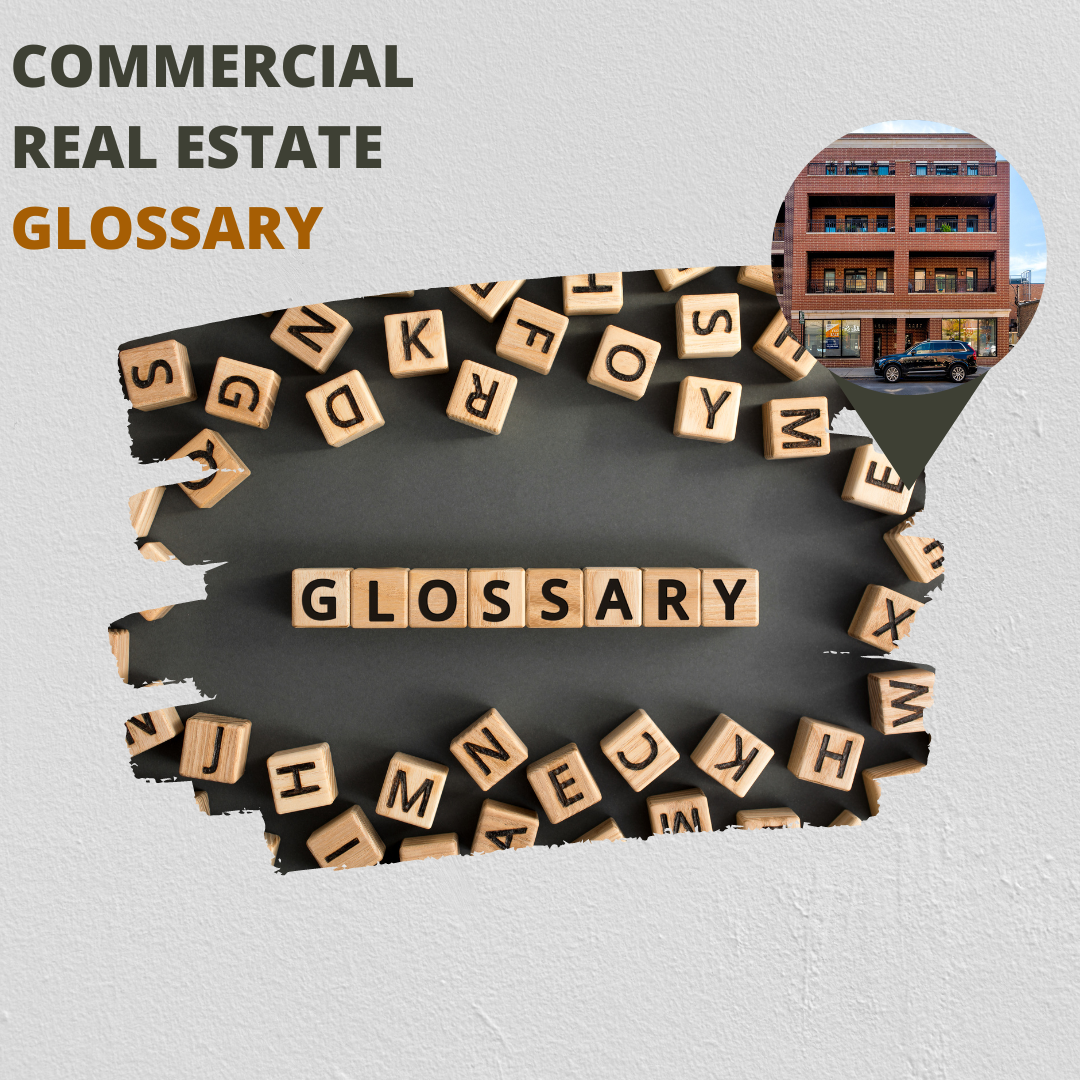Commercial Real Estate Glossary
There are many terms in commercial real estate that industry professionals use causally that most people don’t know. This article covers some of the more widely used words. You should always ask for an explanation if you don’t understand what something means.
Table of Contents
1031 Exchange
A 1031 exchange is a provision in the U.S. tax code that allows real estate investors to defer paying capital gains taxes when they sell one investment property and reinvest the proceeds into another “like-kind” investment property.
With a 1031 exchange, the investor must identify the replacement property within forty-five days of selling the original property and close on the purchase of the replacement property within 180 days.
You can not touch the funds you are using for the 1031 exchange. At closing, it must be wired directly to a qualified intermediary, who holds the funds from the sale of the original property until they are used to purchase the replacement property.
If you are going to execute a 1031 exchange, talk to a qualified intermediary before your property goes under contract. You should also start searching for a replacement property before your property closes. Forty-five days goes by very quickly.
Our clients have always had good things to say about IPX 1031. Check them out if you are looking for an intermediary. – https://www.ipx1031.com/
Adjustable Rate Mortgage (Arm)
An ARM (Adjustable Rate Mortgage) is a type of mortgage where the interest rate changes over time.
Typically, the interest rate is fixed for an initial period (e.g., 3, 5, or 7 years) and then adjusts periodically. Most apartment building loans have an arm so the buyer can get the best rate. Pay attention to when your rate will change (and market interest rates) so you can refinance or sell the property at the appropriate time.
Capitalization Rate (Cap Rate)
Cap rate, short for capitalization rate, is a financial metric used in real estate to determine the rate of return on investment property.
The cap rate is the return a property produces if purchased without a loan. Like any other investment, a property with a low rate of return should be a safe investment. The higher the return, the riskier the investment. If you have a risky property with a low cap rate and there is no way to increase revenue. It may be overpriced.
Cap Rate = NOI / Current Market Value or Sale Price
The problem with cap rates is based on the expenses reported by owners or brokers. Make sure you do your due diligence to analyze the true cap rate.
Cash on Cash Return
Cash on cash return is a ratio used to measure the profitability of an investment in real estate. It is calculated by dividing the annual cash flow generated by the property by the amount of cash initially invested in the property.
Cash on Cash Return = Annual Before-Tax Cash Flow / Total Cash Invested
This is a quick and easy way to figure out if a deal is worth getting involved in.
Debt Service Coverage Ratio (DSCR)
DSCR is a financial metric that lenders use to evaluate a borrower’s ability to repay a loan on an investment property. It is calculated by dividing the property’s net operating income (NOI) by the annual debt service, which is the total amount of principal and interest payments due each year on the loan.
For example, let’s say you’re looking to purchase an investment property that generates $100,000 per year in NOI, and you’re applying for a loan that requires $80,000 in annual debt service payments. In this case, your DSCR would be 1.25 ($100,000 / $80,000).
Lenders generally look for a DSCR of at least 1.25 or higher. If there’s no way to increase the net revenue and the DSCR falls under 1.25, the deal may be overpriced, and a lender will probably pass on financing it.
Depreciation
Depreciation is a tax deduction that allows investors to recover the cost of an income-producing property over time. This is legal, and there is a formula your accountant follows based on asset type. Why is this great? Because your building can be losing money in the eyes of the IRS, and you can pay less in taxes, but in reality, your building is cash-flowing. You will have that recaptured if you sell the building and don’t do a 1031 exchange. However, it is typically worth doing.
For Sale By Owner (FISBO)
An owner who is selling their property without the representation of an agent.
Gross Rent Multiplier (GRM)
GRM is a real estate metric used to assess an income-producing property’s value by dividing the property’s sale price by its gross annual rental income.
GRM = Property Sale Price / Gross Annual Rental Income
For example, if a property is being sold for $500,000 and has a gross annual rental income of $60,000, the GRM would be:
GRM = $500,000 / $60,000 = 8.33
It’s easier to get a real GRM. However, it doesn’t give you much insight as an investor. It’s mainly used as a quick way to see if the building price falls above or below what most other investors are paying in an area.
House Hacking
Purchasing a 2-4 unit property with a residential loan, living in one of the units, and renting out the others. This is an excellent way for investors to start the rental game since the money down is much lower than a 5+ unit building.
However, as an investor looking to buy these properties in good neighborhoods, you will face a lot of competition. These properties have investors and actual homeowners going after them, which typically increases pricing and lowers ROI.
Leasing
This is an expense even if you do the leasing yourself. Most of the time, having a professional get a qualified tenant in the unit as quickly as possible is worth the commission. If you are leasing the property yourself, the time or tools you use must be considered in the cost.
In Chicago, you have the highest amount of renters searching for rental units during late spring and summer. You can have a completely different rent rate and a highly qualified renter just by making sure your leases end around the summertime.
Mixed Use
A building with residential and commercial units.
Multifamily
Another way of saying apartment building.
Multiple Listing Service (MLS)
This is where licensed agents put properties on the market. You can’t access the MLS independently if you aren’t an agent. An agent will have to send you properties from the MLS. Most residential homes go on the MLS to be sold. However, with commercial properties, it depends on the city you are in and the price point. In Chicago, I would say most apartment buildings under a million dollars go on the MLS.
Offering Memorandum (OM)
Offering memorandums is a document that commercial agents use to give buyers all the insight needed for analyzing the property. The most basic information in an OM should be rent, income, and expense.
Owner Financing
This is when the owner is willing to take the place of the bank and let the investor buy the property without paying for the property in full up front. Typically the investor puts a certain percentage down of the asking price and pays a monthly note to the owner.
Proforma
Proforma is a financial statement that projects the potential financial performance of a real estate investment.
Proforma statements estimate a property’s expected income and expenses over a given period. It should take into account things like the purchase price, financing costs, rental income, vacancy rates, operating expenses, potential capital expenditures, etc.
Proforma estimates are usually in the offering memorandum. Do your own due diligence to make sure those numbers are realistic.
Rent Roll
A list of each unit and its rental amount. A good rent roll will include lease start and end dates.
Return on Investment (ROI)- ROI is a financial metric used to measure the profitability of an investment.
ROI = (Net Profit / Cost of Investment) x 100%
Stabilized
A property that is already operating at its highest and best use. These properties typically sell at the highest price points the market will allow.
Trailing 12 (T-12)
This is the income and expenses for a property over the last 12 months broken down by each month.
Under Contract
This is when a property has a buyer who has submitted a written contract that has been accepted.
Unit Mix
The amount and type of units in a building.
Vacancy Rate
How often are units empty in the building? It’s important to remember that vacancy can occur simply with the time it takes for a unit to be filled by a new tenant who has already signed the lease. What I mean is that even if a unit is leased before the other tenant moves, and it takes five days to get it ready, that is still considered in the vacancy rate.
The vacancy rate is provided as a percentage, and different areas have different vacancy rates. Areas with a high concentration of low credit score tenants have a higher vacancy rate due to potential evictions and the time it takes to find a new tenant. The opposite is true in high-credit areas.
Even in the best areas, I still see at least a 3% vacancy rate put into the numbers. In low credit areas, I typically see an 8-12% vacancy rate even if the unit is 100% occupied at the time of purchase.
Value Add
A property that needs some intervention before it can operate at its highest and best use—such as large to small repairs, increasing rents, decreasing expense, better management, etc. These properties are usually sold at a discount.
Wholesaler
In terms of property investors, a wholesaler is a person or company that identifies distressed or under-valued properties, negotiates with the property owner to purchase the property at a discounted price, and then sells the property to another investor for a profit.
This is typically done by the wholesaler putting the property under contract and then assigning the contract to another buyer. This usually creates a serious time crunch, and buyers must act quickly. Sometimes owners know this is taking place sometimes they don’t. If they don’t, this could complicate the end buyers’ due diligence process because it becomes difficult to access the property.
In Illinois, all wholesalers must be licensed real estate agents. That isn’t the case everywhere.
Yield
Investment yield is another financial metric used to measure the profitability of an investment. Investment yield tells you how much income you will receive from an investment as a percentage of the investment’s initial cost.
Rental Yield = (Annual Rental Income / Property Value) x 100%
Zoning
This is a designation given by a local municipality that dictates what type of property can exist on the designated plot of land. Make sure the property you are buying is legally zoned for its use.
-
This author does not have any more posts.





